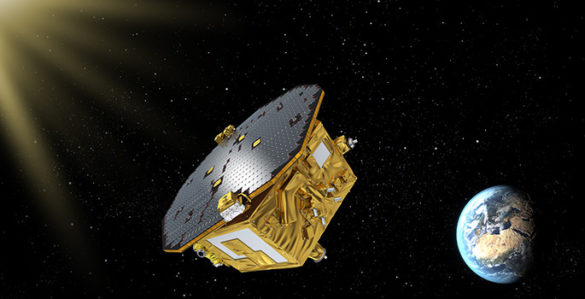
Kelly Holley-Bockelmann, associate professor of astrophysics at Vanderbilt University, has been appointed by NASA’s Astrophysics Directorate to be chair of the U.S. Laser Interferometer Space Antenna (LISA) Study Team, a group of 18 scientists who will advise NASA on science issues related to the proposed space observatory.
LISA, which is designed to take the fledgling field of gravitational wave astronomy to the next level, is an international scientific effort led by the European Space Agency in collaboration with NASA. The $1 billion-plus project consists of three satellites linked by laser beams, all orbiting the sun in an equilateral triangle 2.5 million kilometers on a side, tentatively scheduled for launch in 2030.
Only two years ago, a land-based gravitational wave observatory confirmed Einstein’s prediction that gravitational fluctuations from moving matter excite infinitesimal ripples in space—this first detection of gravitational waves earned the 2017 Nobel Prize in Physics. Just last month, the collision of a pair of neutron stars was observed in both light and gravity through a joint effort involving thousands of astronomers on every continent in the world. These achievements demonstrated that gravitational waves open a new window on the cosmos, one that can provide important new insights into the nature of some of the most violent phenomena in the universe.
Ground-based gravitational wave detectors, such as the Laser Interferometer Gravitational Wave Observatory in the U.S. and the European Gravitational Observatory in Italy, are tuned to detect higher frequency, shorter wavelength ripples in space produced by rotating neutron stars, mergers between neutron stars and stellar mass black holes and stellar explosions. LISA is tuned to detect lower frequencies and longer wavelengths produced by mergers between black holes millions of times more massive than the sun. The space-based system is also designed to track neutron stars and stellar mass black holes in orbit around the massive black hole at heart of the Milky Way, and will map tens of millions of tightly bound binary star systems throughout the galaxy.
As chair of the study team, Holley-Bockelmann will also represent U.S. interests within the international LISA Consortium.

“Our team will lead the U.S. effort to build the new field of gravitational wave astronomy,” said Holley-Bockelmann. “The choices we make will help dictate the pace of discovery, the health and the culture of this new field. Taking a step back, this is the first time we’ve had a chance to build an entirely new field in physics since quantum mechanics about 100 years ago. It’s an incredible time to be an astrophysicist.”
In her new position, Holley-Bockelmann’s goals are to help develop the case for LISA science for the National Academy of Science’s 2020 Decadal Survey, which contains the academy’s recommendations for astronomical research in the next decade. She also intends to act as a representative and advocate for LISA science through invited talks, workshops, town hall meetings, social media and other communication channels.
In addition, Holley-Bockelmann—co-director of the Fisk-Vanderbilt Masters-to-PhD Bridge Program, which assists under-represented minorities obtain doctoral degrees in science, math and engineering—intends to help prepare traditional astronomers and gravitational wave scientists to join forces and combine data from gravitational and conventional astronomical observatories. This “multimessenger astronomy” promises a more comprehensive picture of the titanic collisions, explosions and other cosmic events that generate powerful ripples in space time.
“Oddly enough, I think my work with the Bridge program will be useful here. I know what techniques can help people transition from one type of expertise to another, and hope to implement some of these practices to build a bridge between electromagnetic and gravitational wave astronomers,” she observed.